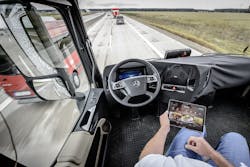MAGDEBURG, GERMANY. Revealing its Mercedes-Benz Future Truck 2025 here during a special media event ahead of the International Commercial Vehicle Show (IAA) in Hanover, Daimler Trucks provided a glimpse into how the “Highway Pilot” technology guiding this tractor-trailer autonomously will function.
Once a truck driver begins driving the Future Truck 2025, a message on the instrument cluster lights up saying "Highway Pilot available." Using an installed map, the truck identifies its position on the highway. The driver switches on the system and takes his hands off the wheel. The display confirms with “Highway Pilot active.”
[To view more photos, please click here.]
The truck continues to travel at exactly the set speed in the center of the right-hand lane. Relying on computers and sensors, the truck’s steering executes slight corrections – even from subtle changes such as crosswinds – automatically. At this point, the driver can relax and even adjust the seat 45 degrees to a more comfortable seating position.
When Highway Pilot is activated, information in the instrumentation cluster is reduced to a minimum and all the data appears on the screen of the tablet computer in the center console, which becomes the truck’s central control and communication instrument.
Under Highway Pilot, the driver cannot leave his seat or sleep; he must respond to periodic prompts that he is awake. But otherwise the driver is free to do what he wants – handle e-mail, listen to music or use the tablet to plan his next fuel stop, pre-order a meal or reserve parking space, for example.
While Highway Pilot is active it maintains a set cruising speed and vehicle separation and adjusts for exceptions. In the July 3 demonstration, for example, the Future Truck 2025 automatically moved to the left of the lane to pass a vehicle that was stationary in the emergency lane and moves back to the normal lane position once it passes stalled vehicle.
The truck driver always is in full control; he can override Highway Pilot at any time through steering, braking or accelerating.
One common example would be if the truck encounters a slow-moving vehicle in its own lane. In Highway Pilot mode, the truck would simply slow down and maintain separation behind the slow-moving vehicle.
But if the driver wants to maintain cruising speed, he returns the seat to driving position, takes over manual control and accelerates to overtake and pass the vehicle. After returning to his lane he can reactivate Highway Pilot.
